HRMG310 Global HRM: Strategic Decision on Offshore Country Selection
VerifiedAdded on 2023/06/07
|13
|3095
|204
Report
AI Summary
This report provides a comprehensive analysis of Afghanistan and India as potential host countries for offshore operations, considering factors such as political stability, economic environment, social aspects, technological advancements, and environmental challenges through a PESTLE analysis. It delves into the core issues and costs involved in Foreign Direct Investment (FDI) in both countries, highlighting the risk factors associated with each, including security threats in Afghanistan and corruption in India. The report concludes with recommendations, emphasizing India's competitive advantages such as cheap labor, stable economic growth, and technological advancements, while acknowledging the importance of talent management and workforce diversification. The document is available on Desklib, a platform offering study tools and solved assignments for students.
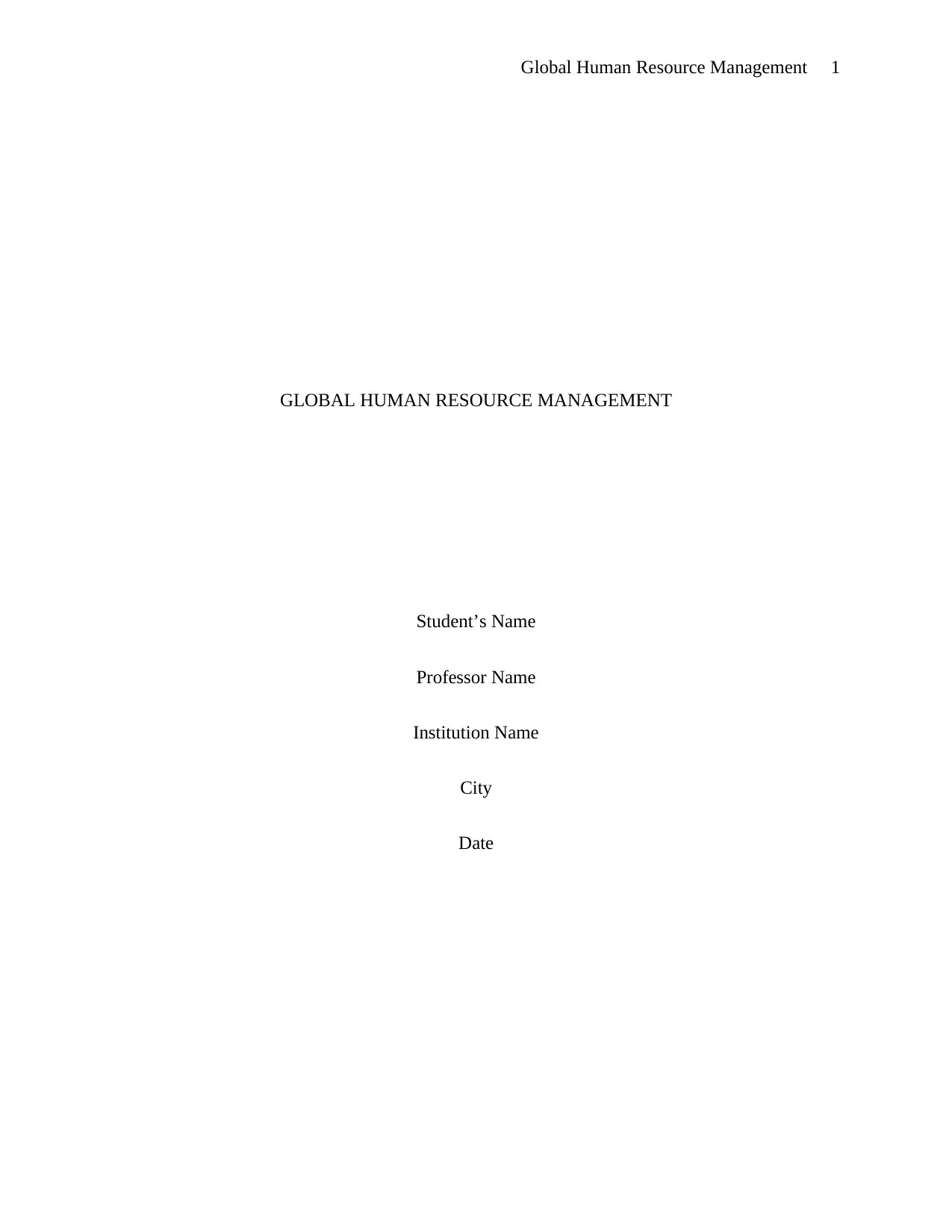
Global Human Resource Management 1
GLOBAL HUMAN RESOURCE MANAGEMENT
Student’s Name
Professor Name
Institution Name
City
Date
GLOBAL HUMAN RESOURCE MANAGEMENT
Student’s Name
Professor Name
Institution Name
City
Date
Paraphrase This Document
Need a fresh take? Get an instant paraphrase of this document with our AI Paraphraser
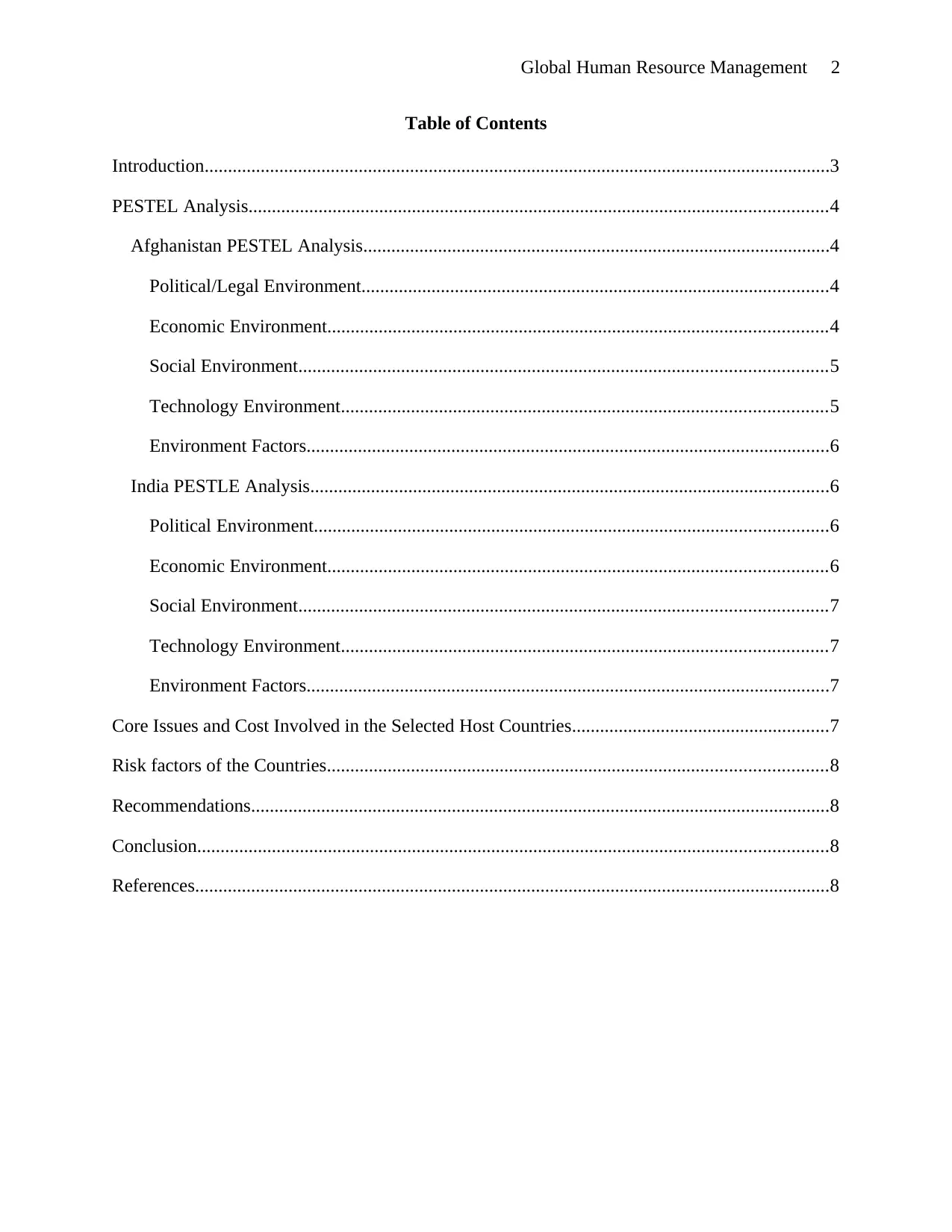
Global Human Resource Management 2
Table of Contents
Introduction......................................................................................................................................3
PESTEL Analysis............................................................................................................................4
Afghanistan PESTEL Analysis....................................................................................................4
Political/Legal Environment....................................................................................................4
Economic Environment...........................................................................................................4
Social Environment.................................................................................................................5
Technology Environment........................................................................................................5
Environment Factors................................................................................................................6
India PESTLE Analysis...............................................................................................................6
Political Environment..............................................................................................................6
Economic Environment...........................................................................................................6
Social Environment.................................................................................................................7
Technology Environment........................................................................................................7
Environment Factors................................................................................................................7
Core Issues and Cost Involved in the Selected Host Countries.......................................................7
Risk factors of the Countries...........................................................................................................8
Recommendations............................................................................................................................8
Conclusion.......................................................................................................................................8
References........................................................................................................................................8
Table of Contents
Introduction......................................................................................................................................3
PESTEL Analysis............................................................................................................................4
Afghanistan PESTEL Analysis....................................................................................................4
Political/Legal Environment....................................................................................................4
Economic Environment...........................................................................................................4
Social Environment.................................................................................................................5
Technology Environment........................................................................................................5
Environment Factors................................................................................................................6
India PESTLE Analysis...............................................................................................................6
Political Environment..............................................................................................................6
Economic Environment...........................................................................................................6
Social Environment.................................................................................................................7
Technology Environment........................................................................................................7
Environment Factors................................................................................................................7
Core Issues and Cost Involved in the Selected Host Countries.......................................................7
Risk factors of the Countries...........................................................................................................8
Recommendations............................................................................................................................8
Conclusion.......................................................................................................................................8
References........................................................................................................................................8
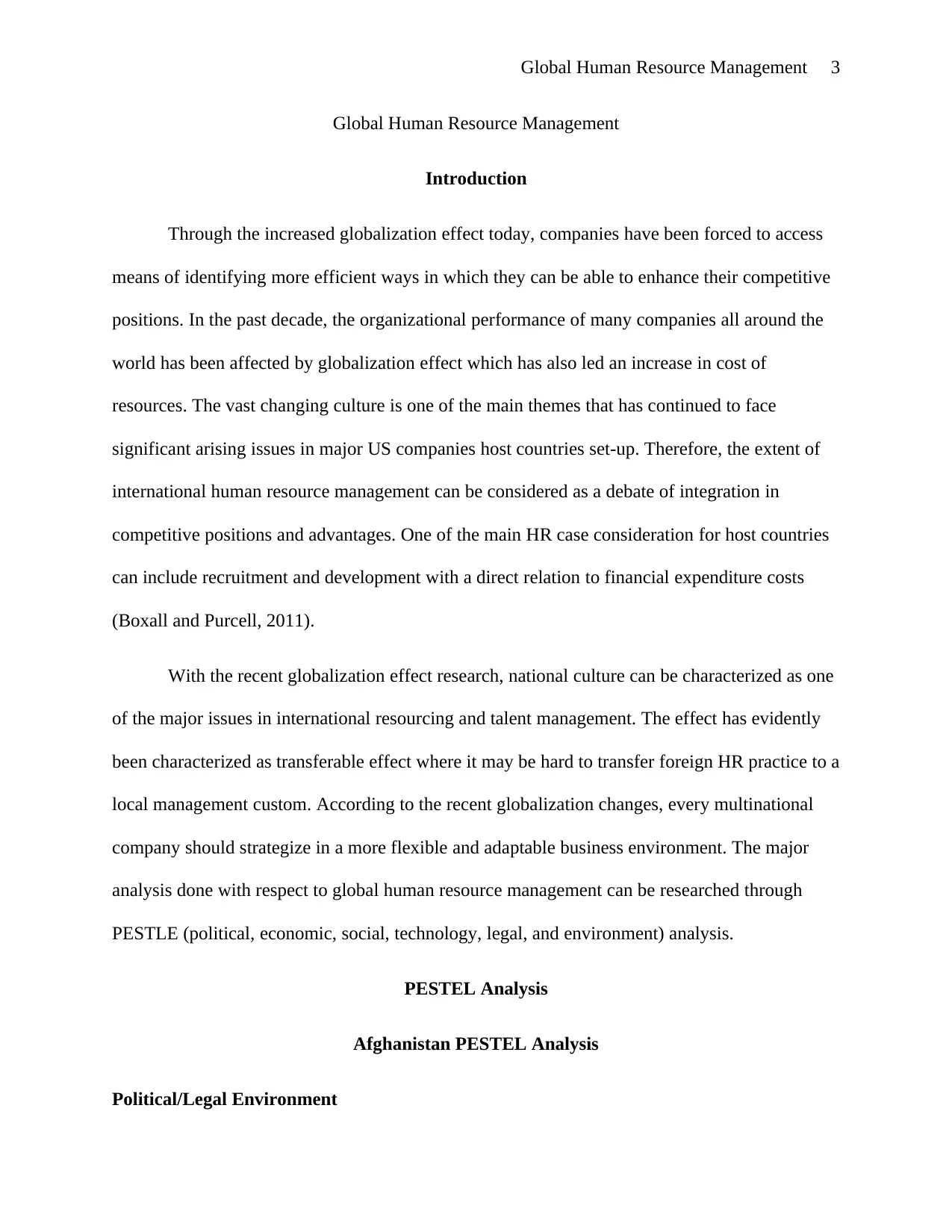
Global Human Resource Management 3
Global Human Resource Management
Introduction
Through the increased globalization effect today, companies have been forced to access
means of identifying more efficient ways in which they can be able to enhance their competitive
positions. In the past decade, the organizational performance of many companies all around the
world has been affected by globalization effect which has also led an increase in cost of
resources. The vast changing culture is one of the main themes that has continued to face
significant arising issues in major US companies host countries set-up. Therefore, the extent of
international human resource management can be considered as a debate of integration in
competitive positions and advantages. One of the main HR case consideration for host countries
can include recruitment and development with a direct relation to financial expenditure costs
(Boxall and Purcell, 2011).
With the recent globalization effect research, national culture can be characterized as one
of the major issues in international resourcing and talent management. The effect has evidently
been characterized as transferable effect where it may be hard to transfer foreign HR practice to a
local management custom. According to the recent globalization changes, every multinational
company should strategize in a more flexible and adaptable business environment. The major
analysis done with respect to global human resource management can be researched through
PESTLE (political, economic, social, technology, legal, and environment) analysis.
PESTEL Analysis
Afghanistan PESTEL Analysis
Political/Legal Environment
Global Human Resource Management
Introduction
Through the increased globalization effect today, companies have been forced to access
means of identifying more efficient ways in which they can be able to enhance their competitive
positions. In the past decade, the organizational performance of many companies all around the
world has been affected by globalization effect which has also led an increase in cost of
resources. The vast changing culture is one of the main themes that has continued to face
significant arising issues in major US companies host countries set-up. Therefore, the extent of
international human resource management can be considered as a debate of integration in
competitive positions and advantages. One of the main HR case consideration for host countries
can include recruitment and development with a direct relation to financial expenditure costs
(Boxall and Purcell, 2011).
With the recent globalization effect research, national culture can be characterized as one
of the major issues in international resourcing and talent management. The effect has evidently
been characterized as transferable effect where it may be hard to transfer foreign HR practice to a
local management custom. According to the recent globalization changes, every multinational
company should strategize in a more flexible and adaptable business environment. The major
analysis done with respect to global human resource management can be researched through
PESTLE (political, economic, social, technology, legal, and environment) analysis.
PESTEL Analysis
Afghanistan PESTEL Analysis
Political/Legal Environment
⊘ This is a preview!⊘
Do you want full access?
Subscribe today to unlock all pages.

Trusted by 1+ million students worldwide
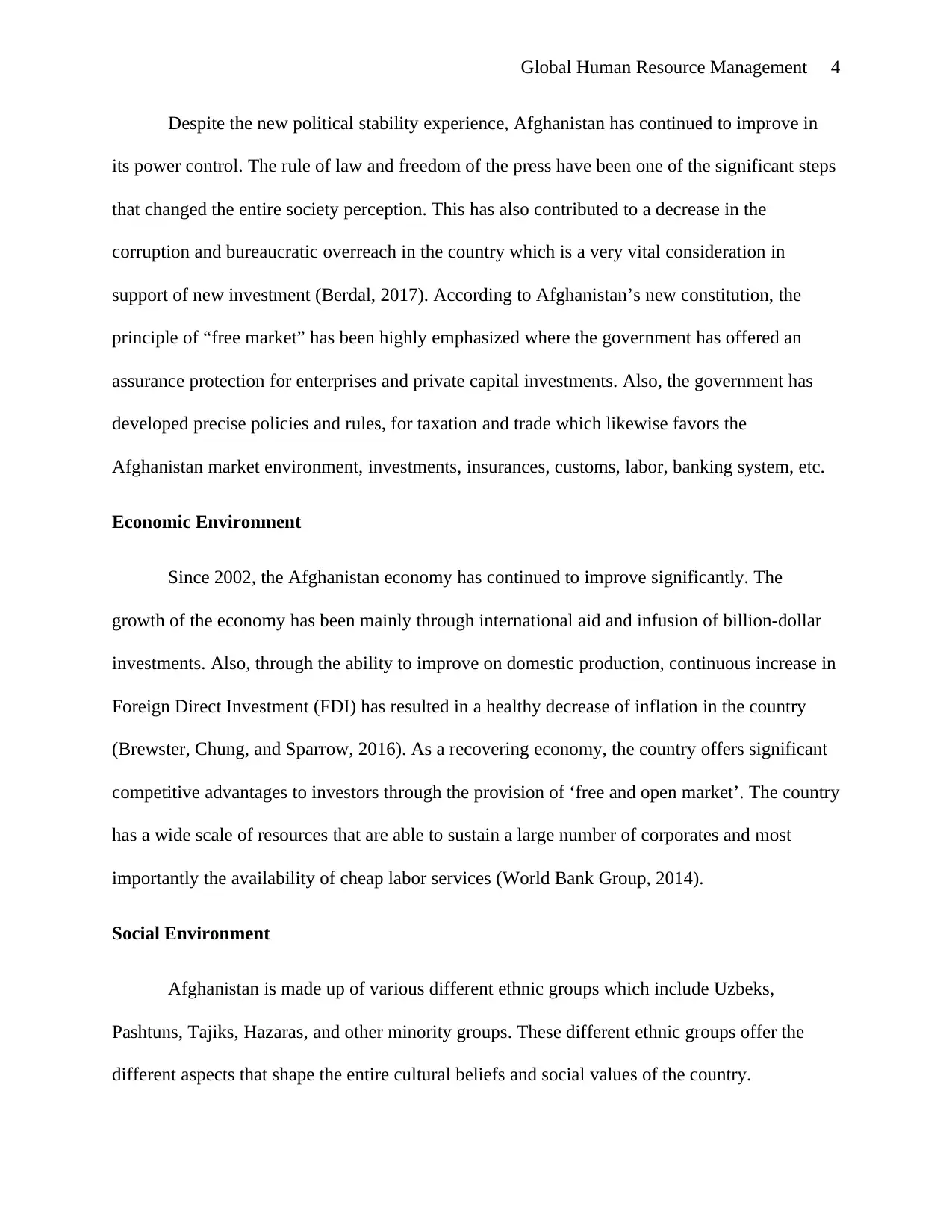
Global Human Resource Management 4
Despite the new political stability experience, Afghanistan has continued to improve in
its power control. The rule of law and freedom of the press have been one of the significant steps
that changed the entire society perception. This has also contributed to a decrease in the
corruption and bureaucratic overreach in the country which is a very vital consideration in
support of new investment (Berdal, 2017). According to Afghanistan’s new constitution, the
principle of “free market” has been highly emphasized where the government has offered an
assurance protection for enterprises and private capital investments. Also, the government has
developed precise policies and rules, for taxation and trade which likewise favors the
Afghanistan market environment, investments, insurances, customs, labor, banking system, etc.
Economic Environment
Since 2002, the Afghanistan economy has continued to improve significantly. The
growth of the economy has been mainly through international aid and infusion of billion-dollar
investments. Also, through the ability to improve on domestic production, continuous increase in
Foreign Direct Investment (FDI) has resulted in a healthy decrease of inflation in the country
(Brewster, Chung, and Sparrow, 2016). As a recovering economy, the country offers significant
competitive advantages to investors through the provision of ‘free and open market’. The country
has a wide scale of resources that are able to sustain a large number of corporates and most
importantly the availability of cheap labor services (World Bank Group, 2014).
Social Environment
Afghanistan is made up of various different ethnic groups which include Uzbeks,
Pashtuns, Tajiks, Hazaras, and other minority groups. These different ethnic groups offer the
different aspects that shape the entire cultural beliefs and social values of the country.
Despite the new political stability experience, Afghanistan has continued to improve in
its power control. The rule of law and freedom of the press have been one of the significant steps
that changed the entire society perception. This has also contributed to a decrease in the
corruption and bureaucratic overreach in the country which is a very vital consideration in
support of new investment (Berdal, 2017). According to Afghanistan’s new constitution, the
principle of “free market” has been highly emphasized where the government has offered an
assurance protection for enterprises and private capital investments. Also, the government has
developed precise policies and rules, for taxation and trade which likewise favors the
Afghanistan market environment, investments, insurances, customs, labor, banking system, etc.
Economic Environment
Since 2002, the Afghanistan economy has continued to improve significantly. The
growth of the economy has been mainly through international aid and infusion of billion-dollar
investments. Also, through the ability to improve on domestic production, continuous increase in
Foreign Direct Investment (FDI) has resulted in a healthy decrease of inflation in the country
(Brewster, Chung, and Sparrow, 2016). As a recovering economy, the country offers significant
competitive advantages to investors through the provision of ‘free and open market’. The country
has a wide scale of resources that are able to sustain a large number of corporates and most
importantly the availability of cheap labor services (World Bank Group, 2014).
Social Environment
Afghanistan is made up of various different ethnic groups which include Uzbeks,
Pashtuns, Tajiks, Hazaras, and other minority groups. These different ethnic groups offer the
different aspects that shape the entire cultural beliefs and social values of the country.
Paraphrase This Document
Need a fresh take? Get an instant paraphrase of this document with our AI Paraphraser

Global Human Resource Management 5
Afghanistan can be characterized as an Islamic dominated state. The country has approximately
20.1 million populations where about 71% of the population live in rural areas, 24% live in urban
areas, and about 5% comprise of the nomadic population. In the past decade, the social
environment has considerably improved in terms of improving the social status of people and the
standard of living of various classes (Cadle, Paul, and Turner, 2010). The education level of the
entire population has improved in line with a change in customs, values, and beliefs.
Technology Environment
Technology has been emphasized as a very important part in the development of
Afghanistan infrastructure and economy. The government has improved various means such as
increasing the satellite interconnection range in entire Asia and the entire world at large. ICT
companies have been able to improve the communication system and online services such as
online banking, money transfers, e-governance, and others. Afghanistan has also emphasized on
the issue of outsourcing information and research in order to create a more conducive
technological environment for investors. Through this, Afghanistan offers incredible investment
platform for multinational companies with a guarantee to effective communication system to the
entire world (World Bank Group, 2014).
Environment Factors
Despite the major environmental requirements like in any other country, Afghanistan has
wide range number of natural resources. It has significant oil production facilities which directly
eliminates a high number of costs such as high fuel and energy prices (Cadle, Paul, and Turner,
2010). The ministry of mining and developments projects has created policies and rules that
establish each investor to conducive environment features that exposes the industry to more
Afghanistan can be characterized as an Islamic dominated state. The country has approximately
20.1 million populations where about 71% of the population live in rural areas, 24% live in urban
areas, and about 5% comprise of the nomadic population. In the past decade, the social
environment has considerably improved in terms of improving the social status of people and the
standard of living of various classes (Cadle, Paul, and Turner, 2010). The education level of the
entire population has improved in line with a change in customs, values, and beliefs.
Technology Environment
Technology has been emphasized as a very important part in the development of
Afghanistan infrastructure and economy. The government has improved various means such as
increasing the satellite interconnection range in entire Asia and the entire world at large. ICT
companies have been able to improve the communication system and online services such as
online banking, money transfers, e-governance, and others. Afghanistan has also emphasized on
the issue of outsourcing information and research in order to create a more conducive
technological environment for investors. Through this, Afghanistan offers incredible investment
platform for multinational companies with a guarantee to effective communication system to the
entire world (World Bank Group, 2014).
Environment Factors
Despite the major environmental requirements like in any other country, Afghanistan has
wide range number of natural resources. It has significant oil production facilities which directly
eliminates a high number of costs such as high fuel and energy prices (Cadle, Paul, and Turner,
2010). The ministry of mining and developments projects has created policies and rules that
establish each investor to conducive environment features that exposes the industry to more
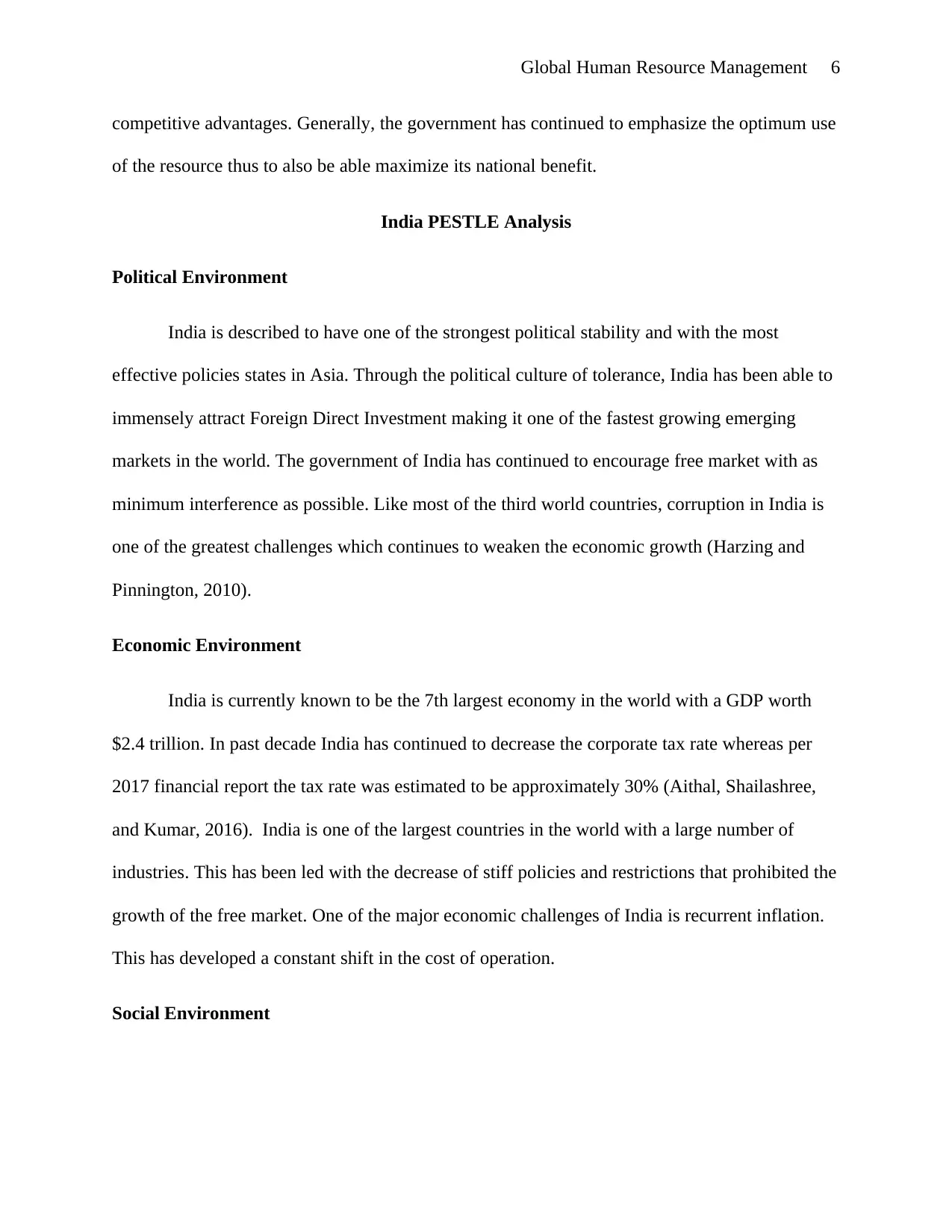
Global Human Resource Management 6
competitive advantages. Generally, the government has continued to emphasize the optimum use
of the resource thus to also be able maximize its national benefit.
India PESTLE Analysis
Political Environment
India is described to have one of the strongest political stability and with the most
effective policies states in Asia. Through the political culture of tolerance, India has been able to
immensely attract Foreign Direct Investment making it one of the fastest growing emerging
markets in the world. The government of India has continued to encourage free market with as
minimum interference as possible. Like most of the third world countries, corruption in India is
one of the greatest challenges which continues to weaken the economic growth (Harzing and
Pinnington, 2010).
Economic Environment
India is currently known to be the 7th largest economy in the world with a GDP worth
$2.4 trillion. In past decade India has continued to decrease the corporate tax rate whereas per
2017 financial report the tax rate was estimated to be approximately 30% (Aithal, Shailashree,
and Kumar, 2016). India is one of the largest countries in the world with a large number of
industries. This has been led with the decrease of stiff policies and restrictions that prohibited the
growth of the free market. One of the major economic challenges of India is recurrent inflation.
This has developed a constant shift in the cost of operation.
Social Environment
competitive advantages. Generally, the government has continued to emphasize the optimum use
of the resource thus to also be able maximize its national benefit.
India PESTLE Analysis
Political Environment
India is described to have one of the strongest political stability and with the most
effective policies states in Asia. Through the political culture of tolerance, India has been able to
immensely attract Foreign Direct Investment making it one of the fastest growing emerging
markets in the world. The government of India has continued to encourage free market with as
minimum interference as possible. Like most of the third world countries, corruption in India is
one of the greatest challenges which continues to weaken the economic growth (Harzing and
Pinnington, 2010).
Economic Environment
India is currently known to be the 7th largest economy in the world with a GDP worth
$2.4 trillion. In past decade India has continued to decrease the corporate tax rate whereas per
2017 financial report the tax rate was estimated to be approximately 30% (Aithal, Shailashree,
and Kumar, 2016). India is one of the largest countries in the world with a large number of
industries. This has been led with the decrease of stiff policies and restrictions that prohibited the
growth of the free market. One of the major economic challenges of India is recurrent inflation.
This has developed a constant shift in the cost of operation.
Social Environment
⊘ This is a preview!⊘
Do you want full access?
Subscribe today to unlock all pages.

Trusted by 1+ million students worldwide

Global Human Resource Management 7
The population of India is one of the largest in the world with an estimation of about 1.2
billion people. This is described as the most diversified population consisting of multi-religious,
multi-ethnic, and multi-lingual. Despite India having a large percentage of poor population, it has
also gradually continued to improve its standard of living (Sridhar et al., 2016). With this, it can
also be described as one of the largest consumer markets in the world with an idle strategic
situation of other large markets such as China and the entire Asian market. India also offers
significant available workforce that is also cheap which has become one of the major effects of
globalization (Briscoe, Tarique, and Schuler, 2012).
Technology Environment
In terms of technology, India is one of the most advanced countries in the world. With
this, India is a host of one of the largest IT companies in the world such as Apple, Microsoft, and
Facebook. The country communication has also outsourced many major companies in the world
which base most of their online administrative operation in India (Khan, Alam, and Alam, 2015).
The government has continued to invest a significant amount in power technology to offer
sustainable energy resources that can support the fast growing economy.
Environment Factors
Environmental challenges are one of the greatest issues facing the country. Some of these
challenges include resources depletion such as forest and water, water pollution, air pollution,
floods, diversion of consumer waste into rivers, and loss of biodiversity. With this harsh
conditions, investors may find difficulty in operating in such an environment (Evans, 2010).
Core Issues and Cost Involved in the Selected Host Countries (Afghanistan and India)
The population of India is one of the largest in the world with an estimation of about 1.2
billion people. This is described as the most diversified population consisting of multi-religious,
multi-ethnic, and multi-lingual. Despite India having a large percentage of poor population, it has
also gradually continued to improve its standard of living (Sridhar et al., 2016). With this, it can
also be described as one of the largest consumer markets in the world with an idle strategic
situation of other large markets such as China and the entire Asian market. India also offers
significant available workforce that is also cheap which has become one of the major effects of
globalization (Briscoe, Tarique, and Schuler, 2012).
Technology Environment
In terms of technology, India is one of the most advanced countries in the world. With
this, India is a host of one of the largest IT companies in the world such as Apple, Microsoft, and
Facebook. The country communication has also outsourced many major companies in the world
which base most of their online administrative operation in India (Khan, Alam, and Alam, 2015).
The government has continued to invest a significant amount in power technology to offer
sustainable energy resources that can support the fast growing economy.
Environment Factors
Environmental challenges are one of the greatest issues facing the country. Some of these
challenges include resources depletion such as forest and water, water pollution, air pollution,
floods, diversion of consumer waste into rivers, and loss of biodiversity. With this harsh
conditions, investors may find difficulty in operating in such an environment (Evans, 2010).
Core Issues and Cost Involved in the Selected Host Countries (Afghanistan and India)
Paraphrase This Document
Need a fresh take? Get an instant paraphrase of this document with our AI Paraphraser
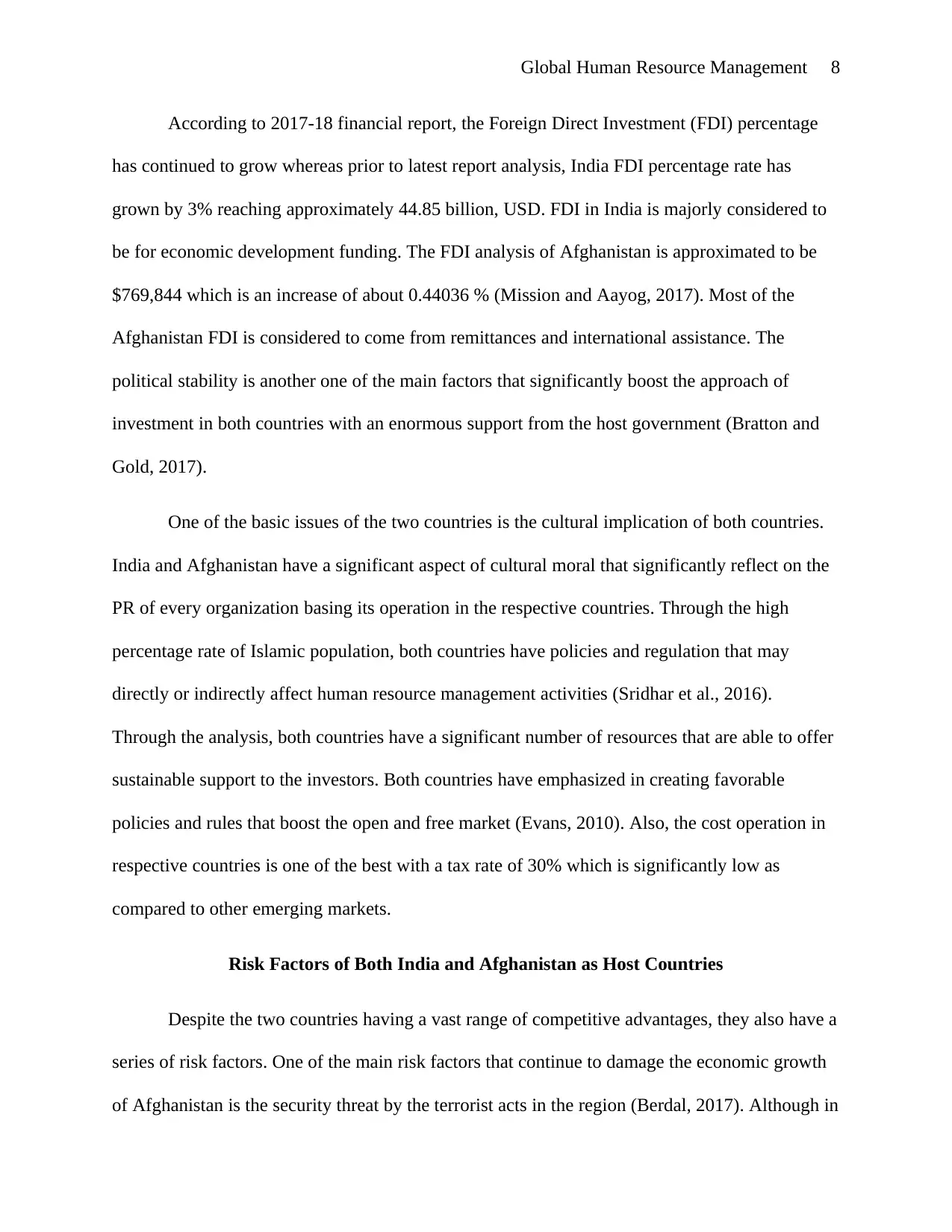
Global Human Resource Management 8
According to 2017-18 financial report, the Foreign Direct Investment (FDI) percentage
has continued to grow whereas prior to latest report analysis, India FDI percentage rate has
grown by 3% reaching approximately 44.85 billion, USD. FDI in India is majorly considered to
be for economic development funding. The FDI analysis of Afghanistan is approximated to be
$769,844 which is an increase of about 0.44036 % (Mission and Aayog, 2017). Most of the
Afghanistan FDI is considered to come from remittances and international assistance. The
political stability is another one of the main factors that significantly boost the approach of
investment in both countries with an enormous support from the host government (Bratton and
Gold, 2017).
One of the basic issues of the two countries is the cultural implication of both countries.
India and Afghanistan have a significant aspect of cultural moral that significantly reflect on the
PR of every organization basing its operation in the respective countries. Through the high
percentage rate of Islamic population, both countries have policies and regulation that may
directly or indirectly affect human resource management activities (Sridhar et al., 2016).
Through the analysis, both countries have a significant number of resources that are able to offer
sustainable support to the investors. Both countries have emphasized in creating favorable
policies and rules that boost the open and free market (Evans, 2010). Also, the cost operation in
respective countries is one of the best with a tax rate of 30% which is significantly low as
compared to other emerging markets.
Risk Factors of Both India and Afghanistan as Host Countries
Despite the two countries having a vast range of competitive advantages, they also have a
series of risk factors. One of the main risk factors that continue to damage the economic growth
of Afghanistan is the security threat by the terrorist acts in the region (Berdal, 2017). Although in
According to 2017-18 financial report, the Foreign Direct Investment (FDI) percentage
has continued to grow whereas prior to latest report analysis, India FDI percentage rate has
grown by 3% reaching approximately 44.85 billion, USD. FDI in India is majorly considered to
be for economic development funding. The FDI analysis of Afghanistan is approximated to be
$769,844 which is an increase of about 0.44036 % (Mission and Aayog, 2017). Most of the
Afghanistan FDI is considered to come from remittances and international assistance. The
political stability is another one of the main factors that significantly boost the approach of
investment in both countries with an enormous support from the host government (Bratton and
Gold, 2017).
One of the basic issues of the two countries is the cultural implication of both countries.
India and Afghanistan have a significant aspect of cultural moral that significantly reflect on the
PR of every organization basing its operation in the respective countries. Through the high
percentage rate of Islamic population, both countries have policies and regulation that may
directly or indirectly affect human resource management activities (Sridhar et al., 2016).
Through the analysis, both countries have a significant number of resources that are able to offer
sustainable support to the investors. Both countries have emphasized in creating favorable
policies and rules that boost the open and free market (Evans, 2010). Also, the cost operation in
respective countries is one of the best with a tax rate of 30% which is significantly low as
compared to other emerging markets.
Risk Factors of Both India and Afghanistan as Host Countries
Despite the two countries having a vast range of competitive advantages, they also have a
series of risk factors. One of the main risk factors that continue to damage the economic growth
of Afghanistan is the security threat by the terrorist acts in the region (Berdal, 2017). Although in
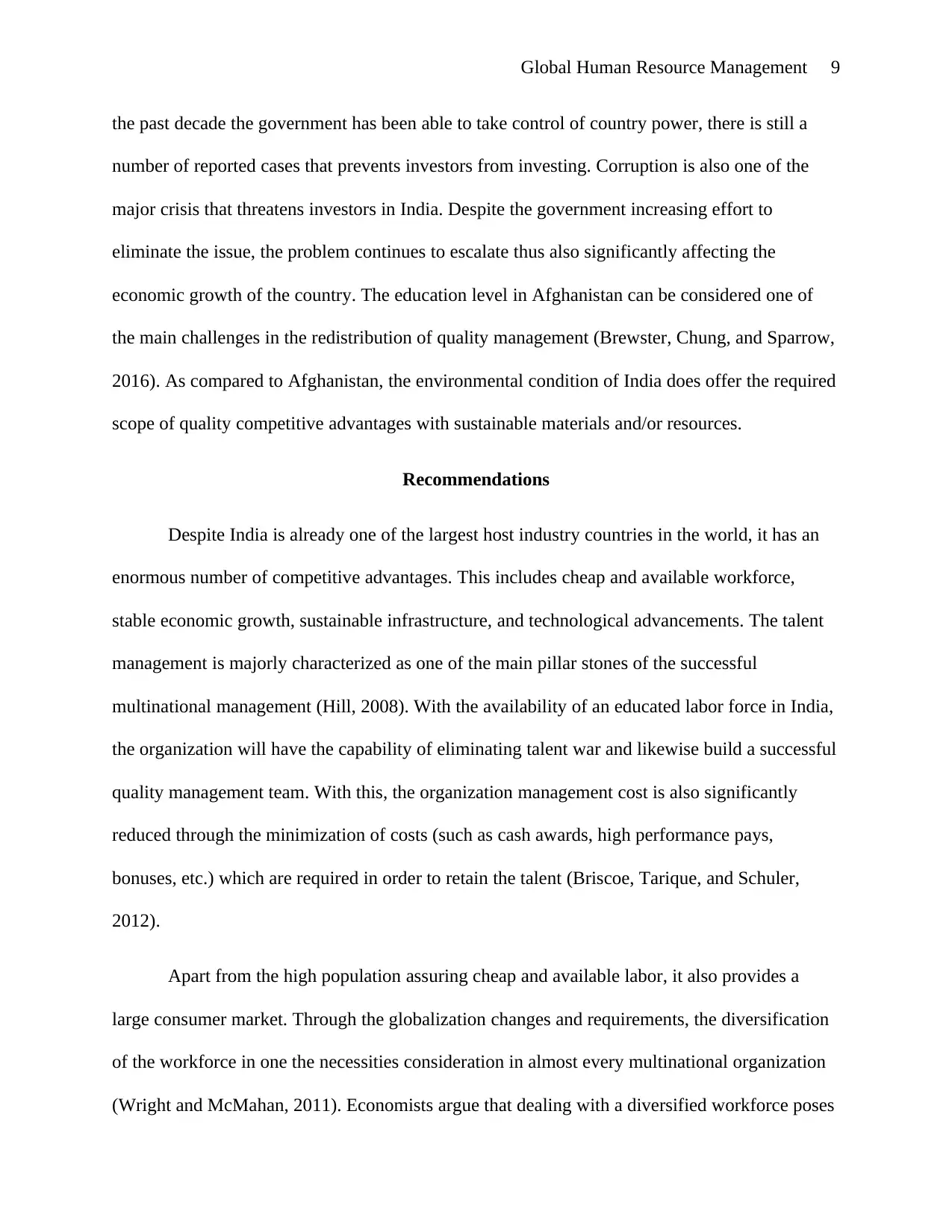
Global Human Resource Management 9
the past decade the government has been able to take control of country power, there is still a
number of reported cases that prevents investors from investing. Corruption is also one of the
major crisis that threatens investors in India. Despite the government increasing effort to
eliminate the issue, the problem continues to escalate thus also significantly affecting the
economic growth of the country. The education level in Afghanistan can be considered one of
the main challenges in the redistribution of quality management (Brewster, Chung, and Sparrow,
2016). As compared to Afghanistan, the environmental condition of India does offer the required
scope of quality competitive advantages with sustainable materials and/or resources.
Recommendations
Despite India is already one of the largest host industry countries in the world, it has an
enormous number of competitive advantages. This includes cheap and available workforce,
stable economic growth, sustainable infrastructure, and technological advancements. The talent
management is majorly characterized as one of the main pillar stones of the successful
multinational management (Hill, 2008). With the availability of an educated labor force in India,
the organization will have the capability of eliminating talent war and likewise build a successful
quality management team. With this, the organization management cost is also significantly
reduced through the minimization of costs (such as cash awards, high performance pays,
bonuses, etc.) which are required in order to retain the talent (Briscoe, Tarique, and Schuler,
2012).
Apart from the high population assuring cheap and available labor, it also provides a
large consumer market. Through the globalization changes and requirements, the diversification
of the workforce in one the necessities consideration in almost every multinational organization
(Wright and McMahan, 2011). Economists argue that dealing with a diversified workforce poses
the past decade the government has been able to take control of country power, there is still a
number of reported cases that prevents investors from investing. Corruption is also one of the
major crisis that threatens investors in India. Despite the government increasing effort to
eliminate the issue, the problem continues to escalate thus also significantly affecting the
economic growth of the country. The education level in Afghanistan can be considered one of
the main challenges in the redistribution of quality management (Brewster, Chung, and Sparrow,
2016). As compared to Afghanistan, the environmental condition of India does offer the required
scope of quality competitive advantages with sustainable materials and/or resources.
Recommendations
Despite India is already one of the largest host industry countries in the world, it has an
enormous number of competitive advantages. This includes cheap and available workforce,
stable economic growth, sustainable infrastructure, and technological advancements. The talent
management is majorly characterized as one of the main pillar stones of the successful
multinational management (Hill, 2008). With the availability of an educated labor force in India,
the organization will have the capability of eliminating talent war and likewise build a successful
quality management team. With this, the organization management cost is also significantly
reduced through the minimization of costs (such as cash awards, high performance pays,
bonuses, etc.) which are required in order to retain the talent (Briscoe, Tarique, and Schuler,
2012).
Apart from the high population assuring cheap and available labor, it also provides a
large consumer market. Through the globalization changes and requirements, the diversification
of the workforce in one the necessities consideration in almost every multinational organization
(Wright and McMahan, 2011). Economists argue that dealing with a diversified workforce poses
⊘ This is a preview!⊘
Do you want full access?
Subscribe today to unlock all pages.

Trusted by 1+ million students worldwide
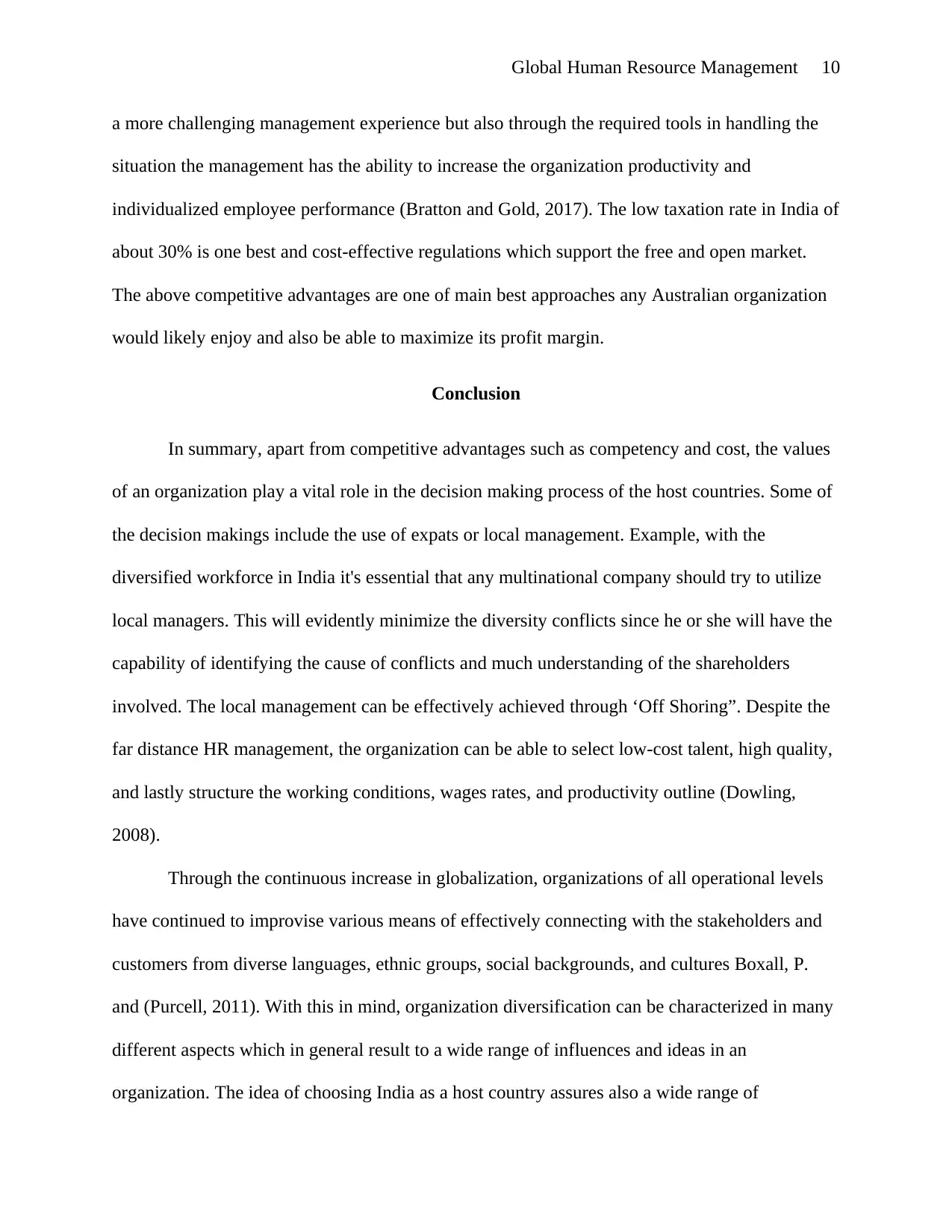
Global Human Resource Management 10
a more challenging management experience but also through the required tools in handling the
situation the management has the ability to increase the organization productivity and
individualized employee performance (Bratton and Gold, 2017). The low taxation rate in India of
about 30% is one best and cost-effective regulations which support the free and open market.
The above competitive advantages are one of main best approaches any Australian organization
would likely enjoy and also be able to maximize its profit margin.
Conclusion
In summary, apart from competitive advantages such as competency and cost, the values
of an organization play a vital role in the decision making process of the host countries. Some of
the decision makings include the use of expats or local management. Example, with the
diversified workforce in India it's essential that any multinational company should try to utilize
local managers. This will evidently minimize the diversity conflicts since he or she will have the
capability of identifying the cause of conflicts and much understanding of the shareholders
involved. The local management can be effectively achieved through ‘Off Shoring”. Despite the
far distance HR management, the organization can be able to select low-cost talent, high quality,
and lastly structure the working conditions, wages rates, and productivity outline (Dowling,
2008).
Through the continuous increase in globalization, organizations of all operational levels
have continued to improvise various means of effectively connecting with the stakeholders and
customers from diverse languages, ethnic groups, social backgrounds, and cultures Boxall, P.
and (Purcell, 2011). With this in mind, organization diversification can be characterized in many
different aspects which in general result to a wide range of influences and ideas in an
organization. The idea of choosing India as a host country assures also a wide range of
a more challenging management experience but also through the required tools in handling the
situation the management has the ability to increase the organization productivity and
individualized employee performance (Bratton and Gold, 2017). The low taxation rate in India of
about 30% is one best and cost-effective regulations which support the free and open market.
The above competitive advantages are one of main best approaches any Australian organization
would likely enjoy and also be able to maximize its profit margin.
Conclusion
In summary, apart from competitive advantages such as competency and cost, the values
of an organization play a vital role in the decision making process of the host countries. Some of
the decision makings include the use of expats or local management. Example, with the
diversified workforce in India it's essential that any multinational company should try to utilize
local managers. This will evidently minimize the diversity conflicts since he or she will have the
capability of identifying the cause of conflicts and much understanding of the shareholders
involved. The local management can be effectively achieved through ‘Off Shoring”. Despite the
far distance HR management, the organization can be able to select low-cost talent, high quality,
and lastly structure the working conditions, wages rates, and productivity outline (Dowling,
2008).
Through the continuous increase in globalization, organizations of all operational levels
have continued to improvise various means of effectively connecting with the stakeholders and
customers from diverse languages, ethnic groups, social backgrounds, and cultures Boxall, P.
and (Purcell, 2011). With this in mind, organization diversification can be characterized in many
different aspects which in general result to a wide range of influences and ideas in an
organization. The idea of choosing India as a host country assures also a wide range of
Paraphrase This Document
Need a fresh take? Get an instant paraphrase of this document with our AI Paraphraser

Global Human Resource Management 11
competitive advantages which will entirely change the performance and productivity of any
Australian company.
competitive advantages which will entirely change the performance and productivity of any
Australian company.
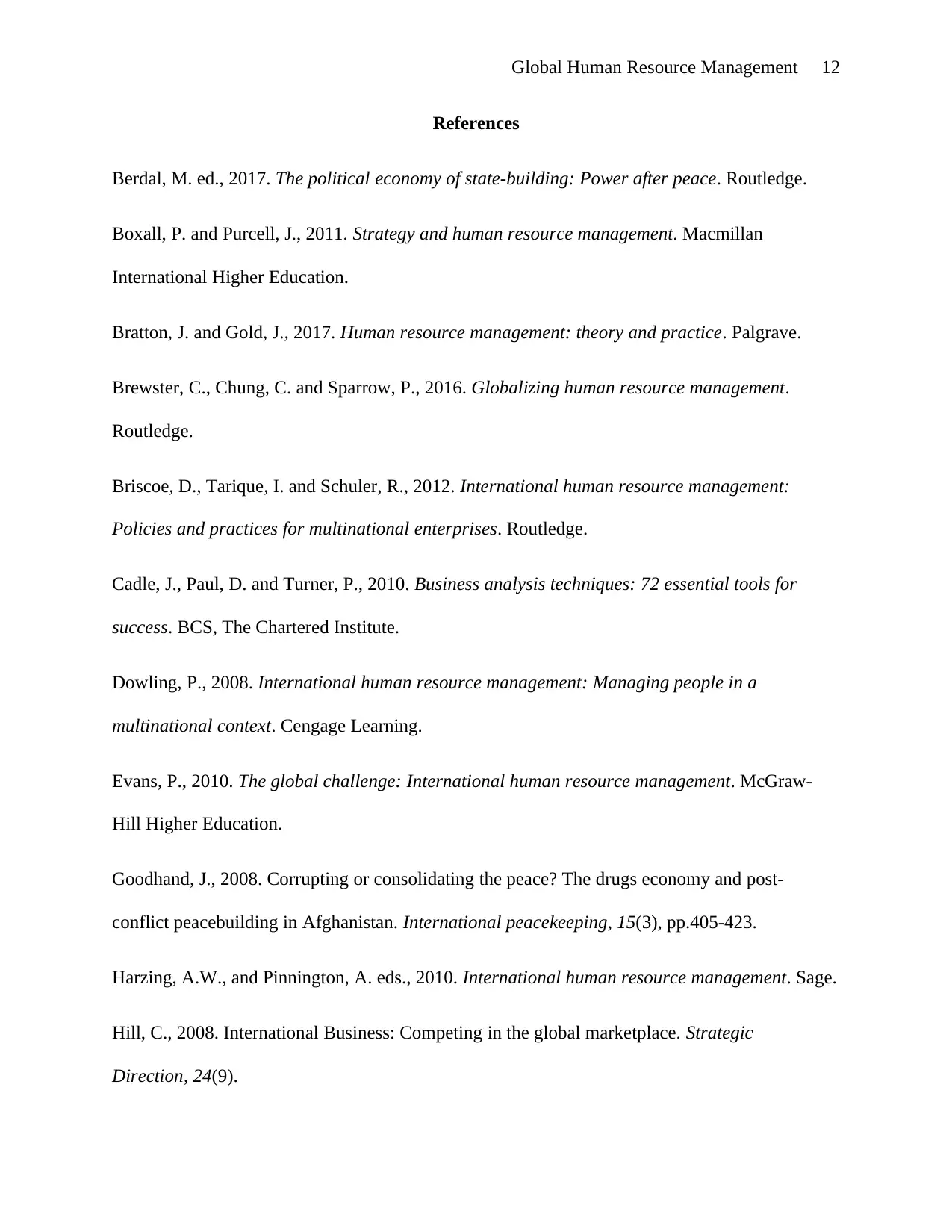
Global Human Resource Management 12
References
Berdal, M. ed., 2017. The political economy of state-building: Power after peace. Routledge.
Boxall, P. and Purcell, J., 2011. Strategy and human resource management. Macmillan
International Higher Education.
Bratton, J. and Gold, J., 2017. Human resource management: theory and practice. Palgrave.
Brewster, C., Chung, C. and Sparrow, P., 2016. Globalizing human resource management.
Routledge.
Briscoe, D., Tarique, I. and Schuler, R., 2012. International human resource management:
Policies and practices for multinational enterprises. Routledge.
Cadle, J., Paul, D. and Turner, P., 2010. Business analysis techniques: 72 essential tools for
success. BCS, The Chartered Institute.
Dowling, P., 2008. International human resource management: Managing people in a
multinational context. Cengage Learning.
Evans, P., 2010. The global challenge: International human resource management. McGraw-
Hill Higher Education.
Goodhand, J., 2008. Corrupting or consolidating the peace? The drugs economy and post-
conflict peacebuilding in Afghanistan. International peacekeeping, 15(3), pp.405-423.
Harzing, A.W., and Pinnington, A. eds., 2010. International human resource management. Sage.
Hill, C., 2008. International Business: Competing in the global marketplace. Strategic
Direction, 24(9).
References
Berdal, M. ed., 2017. The political economy of state-building: Power after peace. Routledge.
Boxall, P. and Purcell, J., 2011. Strategy and human resource management. Macmillan
International Higher Education.
Bratton, J. and Gold, J., 2017. Human resource management: theory and practice. Palgrave.
Brewster, C., Chung, C. and Sparrow, P., 2016. Globalizing human resource management.
Routledge.
Briscoe, D., Tarique, I. and Schuler, R., 2012. International human resource management:
Policies and practices for multinational enterprises. Routledge.
Cadle, J., Paul, D. and Turner, P., 2010. Business analysis techniques: 72 essential tools for
success. BCS, The Chartered Institute.
Dowling, P., 2008. International human resource management: Managing people in a
multinational context. Cengage Learning.
Evans, P., 2010. The global challenge: International human resource management. McGraw-
Hill Higher Education.
Goodhand, J., 2008. Corrupting or consolidating the peace? The drugs economy and post-
conflict peacebuilding in Afghanistan. International peacekeeping, 15(3), pp.405-423.
Harzing, A.W., and Pinnington, A. eds., 2010. International human resource management. Sage.
Hill, C., 2008. International Business: Competing in the global marketplace. Strategic
Direction, 24(9).
⊘ This is a preview!⊘
Do you want full access?
Subscribe today to unlock all pages.

Trusted by 1+ million students worldwide
1 out of 13
Related Documents
Your All-in-One AI-Powered Toolkit for Academic Success.
+13062052269
info@desklib.com
Available 24*7 on WhatsApp / Email
![[object Object]](/_next/static/media/star-bottom.7253800d.svg)
Unlock your academic potential
Copyright © 2020–2025 A2Z Services. All Rights Reserved. Developed and managed by ZUCOL.


